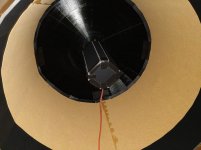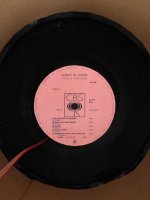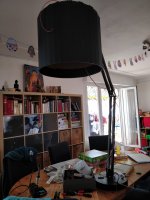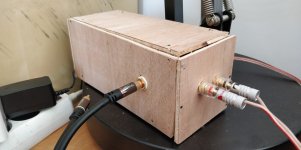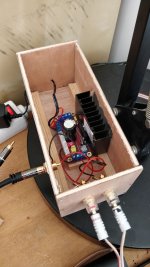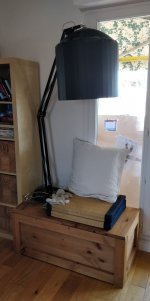Thank you for your advice, I've done the order but with current situation, no idea when I will get all my stuff.
Still I'll reuse my initial prototype (bluetooth small amplifier) and I'll prepare what can be.
I've found the support for the parabola as well, I was planning to do it myself but facing the amount of work, I'll start with that ( I found a cheap 2nd hand one)
I keep you posted.
Still I'll reuse my initial prototype (bluetooth small amplifier) and I'll prepare what can be.
I've found the support for the parabola as well, I was planning to do it myself but facing the amount of work, I'll start with that ( I found a cheap 2nd hand one)
I keep you posted.
I have received the parabola but not yet the stuff to dress it up so I used what I had to make my first tests.
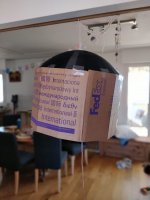
For now let's say it works and my kids are staying below the shower as long as there are stories. I wait for all my parts to finish it up:
- skirt
- amplification
- insulation
I keep you posted

For now let's say it works and my kids are staying below the shower as long as there are stories. I wait for all my parts to finish it up:
- skirt
- amplification
- insulation
I keep you posted
So today I received my foam filled cardboard (inspired by other DIY posts on the forum) so I did the skirt and glued a first layer of cork on the inside of the skirt for basic driver insulation.
Result is good as far as insulation is concerned.
Of course not suitable to open space (sound is leaking by reverberation on the ground) but I think it does pretty good for mid/high range sound in individual office or in living rooms for kids cartoon.
I watched my first movie tonight with it and despite the lack of bass for now (I still miss my amplifier card so I can't fine tune that right now) it was working great (and did not wake up kids or wife).
Here are few pictures while waiting for the amplifier:
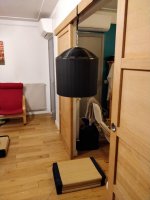
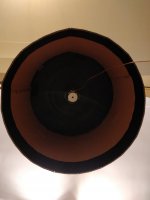
Result is good as far as insulation is concerned.
Of course not suitable to open space (sound is leaking by reverberation on the ground) but I think it does pretty good for mid/high range sound in individual office or in living rooms for kids cartoon.
I watched my first movie tonight with it and despite the lack of bass for now (I still miss my amplifier card so I can't fine tune that right now) it was working great (and did not wake up kids or wife).
Here are few pictures while waiting for the amplifier:


I'm glad it's working for you.
If you are running the driver as shown, the lack of enclosure will limit the bass capability also.
Running as a dipole, there's an inherent 6 dB/octave roll-off in the lower frequencies. This starts having a significant effect around 1500 Hz for a driver of this size. With a near listening distance, the roll-off should be less pronounced though. Your reflector system may extend the lower frequencies also.
At lower playback levels you can equalize the response to be flatter, but you'll run out of Xmax eventually.
If it becomes a problem, a small sealed enclosure can be made for the driver. Around 1 liter is a decent target volume. That will extend the usable low frequencies to around 100 Hz (-10 dB point).
If you are running the driver as shown, the lack of enclosure will limit the bass capability also.
Running as a dipole, there's an inherent 6 dB/octave roll-off in the lower frequencies. This starts having a significant effect around 1500 Hz for a driver of this size. With a near listening distance, the roll-off should be less pronounced though. Your reflector system may extend the lower frequencies also.
At lower playback levels you can equalize the response to be flatter, but you'll run out of Xmax eventually.
If it becomes a problem, a small sealed enclosure can be made for the driver. Around 1 liter is a decent target volume. That will extend the usable low frequencies to around 100 Hz (-10 dB point).
For pure futile decoration purpose I did recreate a vinyl feeling when viewed from below
View attachment 843059
great choice in music to be used for something else
great choice in music to be used for something elsehaha just my opinion

He he, what people do with music and how they listen to it is a matter of personal preference.
If you like the music, here the png file I did, can be used for other purposes (I can't attach svg but if one need to edit, I can share):
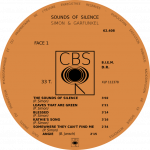
So @MattStat, I've followed your advice and tried to equalize using the miniDSP, audiotools on android and the mic you recommended.
I manage to enhance a lot the initial response curve from peaky between 1500Hz-10KHz to rather flat 500Hz-15KHz.
But the I listen to the music I know from other sound system and it's super bassy (let's say strong lower medium) so I had to minimize a lot my changes to find back something that sounds natural.
Have you got any explanation why that could occur? Am I doing the things wrong (especially trying to reach a flat sound pressure curve)?
I manage to enhance a lot the initial response curve from peaky between 1500Hz-10KHz to rather flat 500Hz-15KHz.
But the I listen to the music I know from other sound system and it's super bassy (let's say strong lower medium) so I had to minimize a lot my changes to find back something that sounds natural.
Have you got any explanation why that could occur? Am I doing the things wrong (especially trying to reach a flat sound pressure curve)?
Are you using an RTA or one of the impulse response modules?
If RTA, are you using pink noise as your test signal?
How are your mic and speaker set up? How are you holding the mic? Distances to nearby large reflective things (walls, floor, ceiling)?
Most people find a totally flat curve a little bright, so if things are working right, you shouldn't be having the impression you are.
If RTA, are you using pink noise as your test signal?
How are your mic and speaker set up? How are you holding the mic? Distances to nearby large reflective things (walls, floor, ceiling)?
Most people find a totally flat curve a little bright, so if things are working right, you shouldn't be having the impression you are.
I was using RTA at first to make a draft tuning, trying to obtain a flatter curve.Are you using an RTA or one of the impulse response modules?
I was using white noise as a test signal.If RTA, are you using pink noise as your test signal?
Speaker is toward the ground at a 1m70cm height.How are your mic and speaker set up? How are you holding the mic? Distances to nearby large reflective things (walls, floor, ceiling)?
Measure was done at the center of the skirt opening at 1m20cm height microphone in upward position.
Of course the whole system I'm measuring is a reflection factory as you know.
Ok I will try pink noise calibration and listen to how it fits my needs, tell me if you have any other idea.Most people find a totally flat curve a little bright, so if things are working right, you shouldn't be having the impression you are.
cheers !
I'm glad the noise signal was the issue. That was the easiest one to fix.
For what you are doing, sticking with RTA and pink noise may give you what you need.
Impulse measurements are more involved and have more problems with reflections from nearby objects. They offer higher resolution under the right conditions, but for most people those conditions are difficult to achieve indoors at low midrange frequencies and below. More judgment and decisions are involved in setting them up and interpreting the results. I'm not trying to discourage you from pursuing them, just letting you know there's a learning curve involved, and that you can get good results with RTA for things like general equalization.
For what you are doing, sticking with RTA and pink noise may give you what you need.
Impulse measurements are more involved and have more problems with reflections from nearby objects. They offer higher resolution under the right conditions, but for most people those conditions are difficult to achieve indoors at low midrange frequencies and below. More judgment and decisions are involved in setting them up and interpreting the results. I'm not trying to discourage you from pursuing them, just letting you know there's a learning curve involved, and that you can get good results with RTA for things like general equalization.
- Status
- This old topic is closed. If you want to reopen this topic, contact a moderator using the "Report Post" button.
- Home
- Loudspeakers
- Planars & Exotics
- [Project] Parabolic speaker
